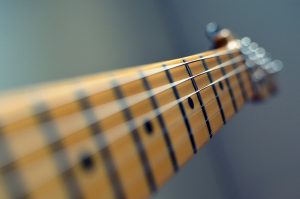Classical, Acoustic, or Electric Guitar: Which is Hardest to Learn?

I’ve been asked this question a lot. Each variant brings its own advantages and disadvantages to the table (especially when you’re first learning it).
One could simply say, they’re all hard to learn really well, but for the sake of interest, I’ll go through a little comparing and contrasting. I’ll attempt to draw a conclusion, and I encourage you to do the same. Let’s start with what I think is most people’s favorite:
Electric Guitar

The king of rock, the instrument of countless iconic musicians. Think of B.B. King, Pat Metheny, Joe Satriani, Steve Vai, Eddie Van Halen, the list goes on. The electric guitar was the instrument of choice for these guitar-gods, and I seriously doubt that it was because it wasn’t hard to learn. But let’s look at some of its advantages and disadvantages.
Advantages
-
Light tension strings. I’ll admit that while it’s not easy to shred like the greats, it’s definitely easier to play a guitar that you don’t have to squeeze the life out of with your left hand. This also makes barre chords easier, but the nature of those beasts always leave you at risk of squeezing too much.
-
The neck is narrow. Approximately 1.7 inches on average. This is a clear advantage for people with small hands, or anyone having to play music that involves stretching the hand to its maximum reach.
-
Nearly endless sustain. Musically speaking, this is a massive advantage over any acoustic guitar. The longer you can hold a note, the more vocal-like quality your playing will have. You can really make the guitar sing!
Disadvantages
-
The narrow neck and light tension strings make it easier to play things like barre chords, but simultaneously make it easier to accidentally mute notes. To mitigate this while playing electric guitar, you must be extremely precise and consistent in your finger placement and movements.
-
Fast scales are a hallmark of electric guitar playing. If you’ve tried to play as fast as Yngwie, you know how challenging it can be. This applies to all three types of guitar, but it’s worth mentioning, given the electric guitar’s reputation for sweeps and scales.
-
You have to plug it in to hear it. I’ve practiced electric guitar without an amp, as I’m sure most players often do. But in order to really hear it, you need extra gear, and that can become bothersome (especially if you’re out gigging all night and have to set your rig up again just to practice). I’d say choose your battles.
Acoustic Guitar
 The first thing that comes to mind for most of us when we hear “acoustic guitar,” is either Wonderwall covers, or your uncle Larry who gets wasted and plays Simple Man all night at the family reunion.
The first thing that comes to mind for most of us when we hear “acoustic guitar,” is either Wonderwall covers, or your uncle Larry who gets wasted and plays Simple Man all night at the family reunion.
I’m talking about your basic steel-string, dreadnought acoustic guitar. And let’s be honest -the acoustic guitar has endured some pretty bad stereotypes as of late (cue the country music stars).
Don’t let those fool you though, because playing it isn’t exactly a walk in the park. Especially if you’re attempting to play music similar to the likes of Michael Chapdelaine, Andy McKee, Alan Gogoll, or Tommy Emmanuel. There are some things that work in a player’s favor though.
Advantages
-
Lots of sustain: Your run-of-the-mill steel string guitar obviously won’t have the sustain of your electric guitar, but next to a classical guitar, this one wins all day long. This makes playing polyphonic music “easier,” because notes can be held for much longer. However, it won’t be easy if you’ve got an acoustic guitar with really high action and high gauge strings.
-
It’s most often played with a pick and strummed, and this is where your stereotype comes from. That being said, there is also a lot of information online to help you get started learning, and that’s an advantage in and of itself. Pick up a few chords and you’re on your way to writing the next hit song!
Disadvantages
The single most difficult thing about acoustic guitar (at least from what I see in my students, and from my own experience) is that it’s physically harder to play. It requires more physical effort from the player in order to play it.
There are always exceptional instruments, but generally speaking, acoustic guitars are known for having lower playability due to higher tension strings and sometimes higher action. That doesn’t mean it wouldn’t be worth your effort though. Many playable acoustic guitars are available at a decent price point too.
Classical Guitar
This style of guitar has grown significantly in popularity over the last two decades, and for good reason. If you’re new to classical guitar, check out some players like David Russel, Rene Izquierdo, Jason Vieaux, Manuel Barrueco, or Celil Refik Kaya and enjoy.
I think most people’s idea of classical guitar has something to do with some guy named Esteban who dresses in all black and wears a bolero hat. Despite the stereotypes, there is a massive and diverse repertoire for the classical guitar stretching back centuries, and it’s not all Spanish! Anyway, let’s talk about some advantages it has.
Advantages
- Nylon strings definitely make the classical guitar appealing to beginners. They aren’t as hard to play as steel strings and that makes it very finger-friendly.
-
Having a wider neck than both a steel-stringed acoustic and an electric mitigates the problems you would run into with an electric guitar -it’s not as easy to accidentally mute notes when playing chords or polyphonic music. On the other hand, the wider neck would make stretches more difficult for people with smaller hands (but they also make classical guitars on a smaller scale).
-
As I mentioned before, the amount of music written for classical guitar (and lute, which translates well to the guitar) goes back centuries, and covers very simple beginner music, all the way through extremely difficult advanced music. So no matter what your playing level is, there’s always something you can play.
Disadvantages
-
In order to play all of that beautiful music, you need to be able to read music. This deters many players from venturing into the classical world. You’ll never meet a classical guitarist who doesn’t read music, but like many things -once you learn it, you’ve learned it.
-
The overall technique of classical guitar is in itself a disadvantage because it requires careful attention to detail when fine-tuning left/right hand position, sitting position, nail shape, tone production, sound projection, all the way down to how you breathe when you play. This often requires a good teacher to show you how it’s done, but I’ve met amazing classical players who learned on their own. It all comes down to how determined a person is.
Conclusion
As I said in the beginning, I think playing any style of guitar at a high level is difficult, and getting there is hard work. Just because of the attention to detail required to play it well, I think classical guitar is the most difficult to learn on your own (as a complete beginner), but there’s nuance to every style of guitar and that takes practice and time.
If you’re just starting out on guitar, don’t worry about which one is harder to learn -just have patience, play what you love, and keep an open mind when listening to other styles. Honestly, the amount of teach-yourself-guitar content that’s out there is astronomical (YouTube, JamPlay, and Tonebase) so you have every opportunity to learn whatever style you’d like -just practice!
